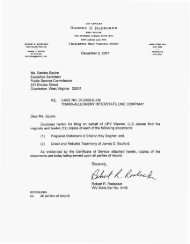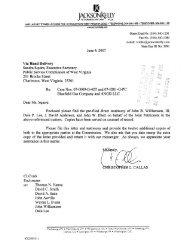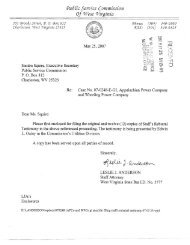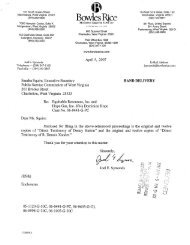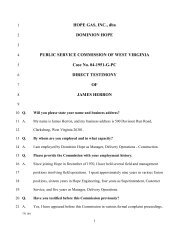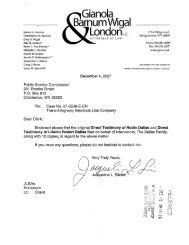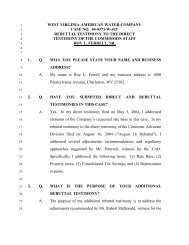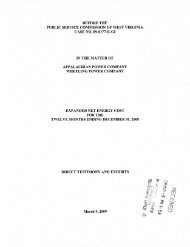Direct Testimony of Thomas M. Hildebrand - Consumer Advocate ...
Direct Testimony of Thomas M. Hildebrand - Consumer Advocate ...
Direct Testimony of Thomas M. Hildebrand - Consumer Advocate ...
You also want an ePaper? Increase the reach of your titles
YUMPU automatically turns print PDFs into web optimized ePapers that Google loves.
constraints.‘ Similarly. ISOs and RTOs estimate the<br />
degree to which congestion in specific areas would<br />
bs alleviated by transmission upgrades, because<br />
major reductions in congestion mean bill savings<br />
for electricity customers.’ Congestion also occurs in<br />
areas where thc grid is managed by individual integated<br />
utilities rather than by regional grid operators:<br />
however, since transmission, generation and<br />
redispatch costs are less visible in these areas, the<br />
costs <strong>of</strong> congestion are not as readily identifiable.<br />
As the tenn is used here, reliability refers to the delivery<br />
<strong>of</strong> electricity to customers in the amounts desired<br />
and within accepted standards for the frequency,<br />
duration, and magnitude <strong>of</strong> outages and<br />
other adverse conditions or e\*ents. Loadpockets are<br />
created when a major load center (such as a large<br />
city llke San Francisco or New York) has too little<br />
local generation relative to load and must import<br />
much <strong>of</strong> its electricity via transmission from neighbo+iing<br />
regions. For example, most <strong>of</strong> California is<br />
currently a generation-short load pocket; by contrast,<br />
transmission constraints cause Maine, which<br />
has far more generation than load, to be generation-rich.<br />
Because it is frequently difficult to site<br />
and build efficient new generation within a city, or<br />
to build additional transmission into a city, the resulting<br />
load pocket will <strong>of</strong>ten experience congestion-meaning<br />
it cannot import as much low-cost<br />
energy as it would like, and the city’s electricity<br />
provider(s) must operate one or iiiore existing<br />
power plants inside the city more intensively to ensure<br />
that all customer needs are met, although at<br />
higher cost. If electricity demand inside the load<br />
pocket grows quickly without being checked by energy<br />
efficiency and demand response, the load<br />
I<br />
pocket may face a looming reliability problem, vi ith<br />
too little supply (local generation plus transmission-eilabled<br />
imports) relative to demand-whether<br />
in actual ternis or according to accepted rules for<br />
safe grid operation. In such cases. it is necessary for<br />
the transmission owner(s) serving the load pocket to<br />
resolve the reliability problem as quickly as possible.<br />
7,<br />
e case <strong>of</strong> a load pocket, thcre arc three primary 1<br />
ways to deal with a long-teim congestion problem:<br />
1.<br />
Build new central-station generation within the<br />
load pocket;<br />
2. Build ncw or upgrade transmission capacity<br />
(some combination <strong>of</strong> lines and other equipment<br />
such as transfomiers and capacitors) to cnable<br />
distant generators to senre a portion <strong>of</strong> the<br />
area’s load; or<br />
3. Reduce electricity demand (and net import<br />
needs) within the load pocket, through some<br />
combination <strong>of</strong> energy efficiency. demand response.<br />
and distributed generation.<br />
The three options can be used singly or in combination<br />
to solve a transmission constraint problcni<br />
flexibly and cost-effectively. Generation and transmission,<br />
however, are costly, time-consuming solutions<br />
that <strong>of</strong>ten face opposition. Demand-side options<br />
tend to be under-utilized because they have<br />
high transaction costs with results that may be less<br />
certain and less controllable. It should also be noted<br />
that there are a variety <strong>of</strong> transmission-only solutions<br />
to any specific transmission problem; not cyery<br />
transmission project (or cornbination <strong>of</strong> projects)<br />
will provide equal congestion relief, nor will<br />
it provide equal reliability or economic benefits to<br />
one in the affected region.<br />
\-p.o.-^------ -<br />
‘See, for example. PJM’s statement that congestion costs resulting from constraints in the Allegheny Mountain area azotaled S747 million in 1005.<br />
with another $464 million on the Delaware River path that year. Se<br />
.Int~rest-L.ansinissioc-iomci~r-s pdi^ for additional detail. Organized<br />
to protect themselves irnd prevent the full cost <strong>of</strong> congestion from driving up their total deljvered electticity costs.<br />
‘It is important to note that the purpose <strong>of</strong> this study was to identifj areas experiencins significant congestion, as opposed 10 estimating the net<br />
value <strong>of</strong> actions to address thc congcstion. See, for example., the CAISO’s estimate that transmission upgrades and operatianal impravcnienrs<br />
czonioleted in 2005 reduced summer congestion costs by more than $54 million in just two months (IIIPJ: ,ww,..2aiso cc.m.docs:<br />
, and that three newly approsed transmission project<br />
bonknecks and maintaining ackquate generalion for local rzliability by $30 million per year”<br />
4 US. Department <strong>of</strong> Energy I National Electric Transmission Congestion Study ‘ 2006



